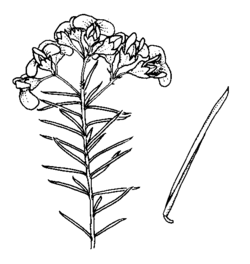Dillwynia retorta (J.C.Wendl.) Druce APNI* Synonyms: Dillwynia ericifolia var. deflexa Blakely APNI*
Dillwynia retorta subsp. A sensu Jacobs & Pickard (1981) APNI*
Dillwynia retorta (J.C.Wendl.) Druce species complex APNI*

Description: Erect shrub to 3 m high; stems pubescent to pilose.
Leaves spirally twisted, linear to narrow-oblong, 4–12 mm long, apex shortly acuminate and often curved, smooth or minutely tuberculate, glabrous.
Inflorescences capitate, umbellate or racemose, terminal and in the upper axils, sometimes tightly clustered, 1–9-flowered; peduncles 0–2 cm long, often bearing bracts below the flowers; bracts 1–2 mm long; bracteoles 1–3 mm long. Calyx 3–6 mm long, glabrous externally, often shortly ciliate. Standard 5–12 mm long.
Pod 4–7 mm long; seeds smooth.
Distribution and occurrence: North from Budawang Ra. In heath to dry sclerophyll forest on acidic, well-drained soils.
NSW subdivisions: NC, NT, CC, SC, CT, NWS, CWS
Other Australian states: Qld
This complex includes 2 species that grow together on Hawkesbury sandstone in the Sydney region. Other regional variants may belong to additional distinct taxa. The complex is under revision.
Text by P.H. Weston & P.C. Jobson
Taxon concept:
APNI* Provides a link to the Australian Plant Name Index (hosted by the Australian National Botanic Gardens) for comprehensive bibliographic data
***The AVH map option provides a detailed interactive Australia wide distribution map drawn from collections held by all major Australian herbaria participating in the Australian Virtual Herbarium project.
|


